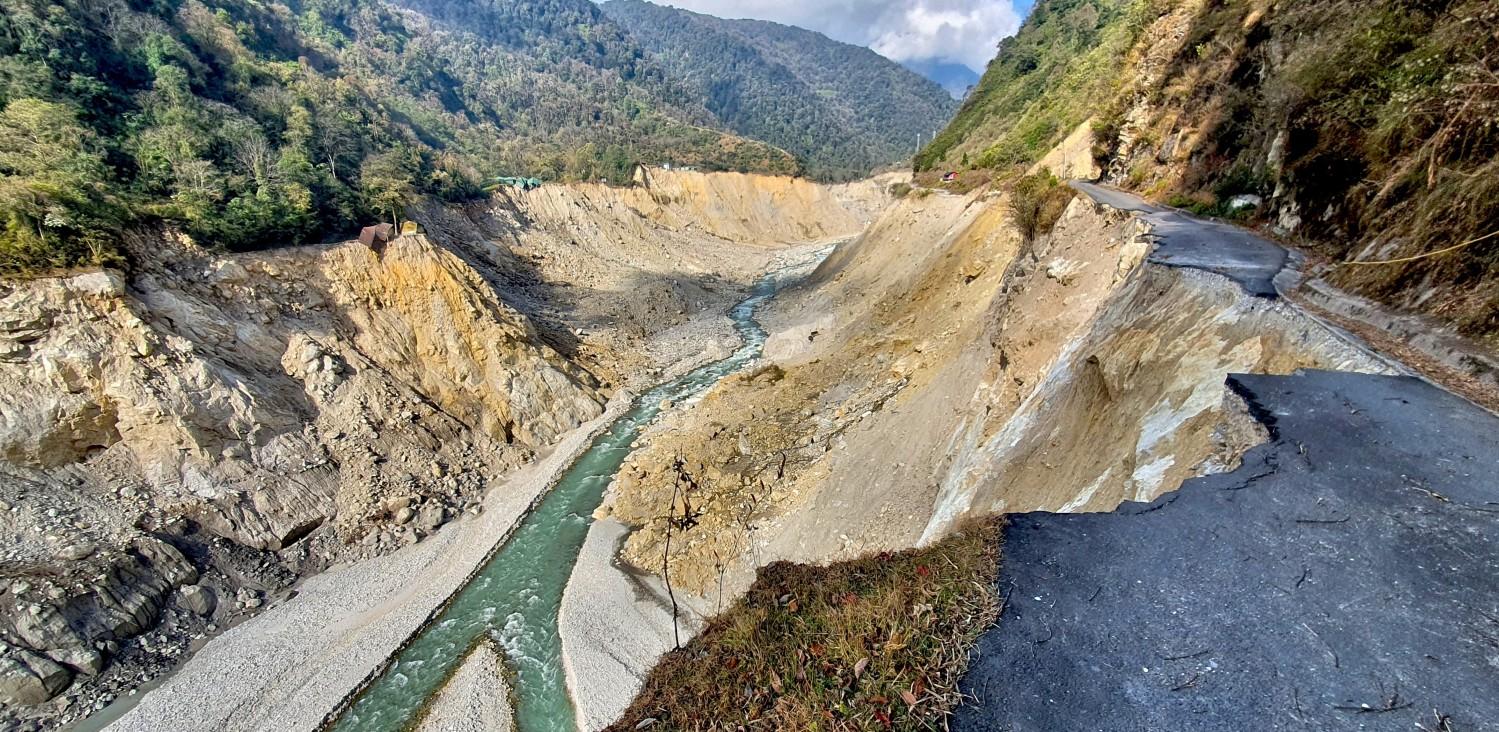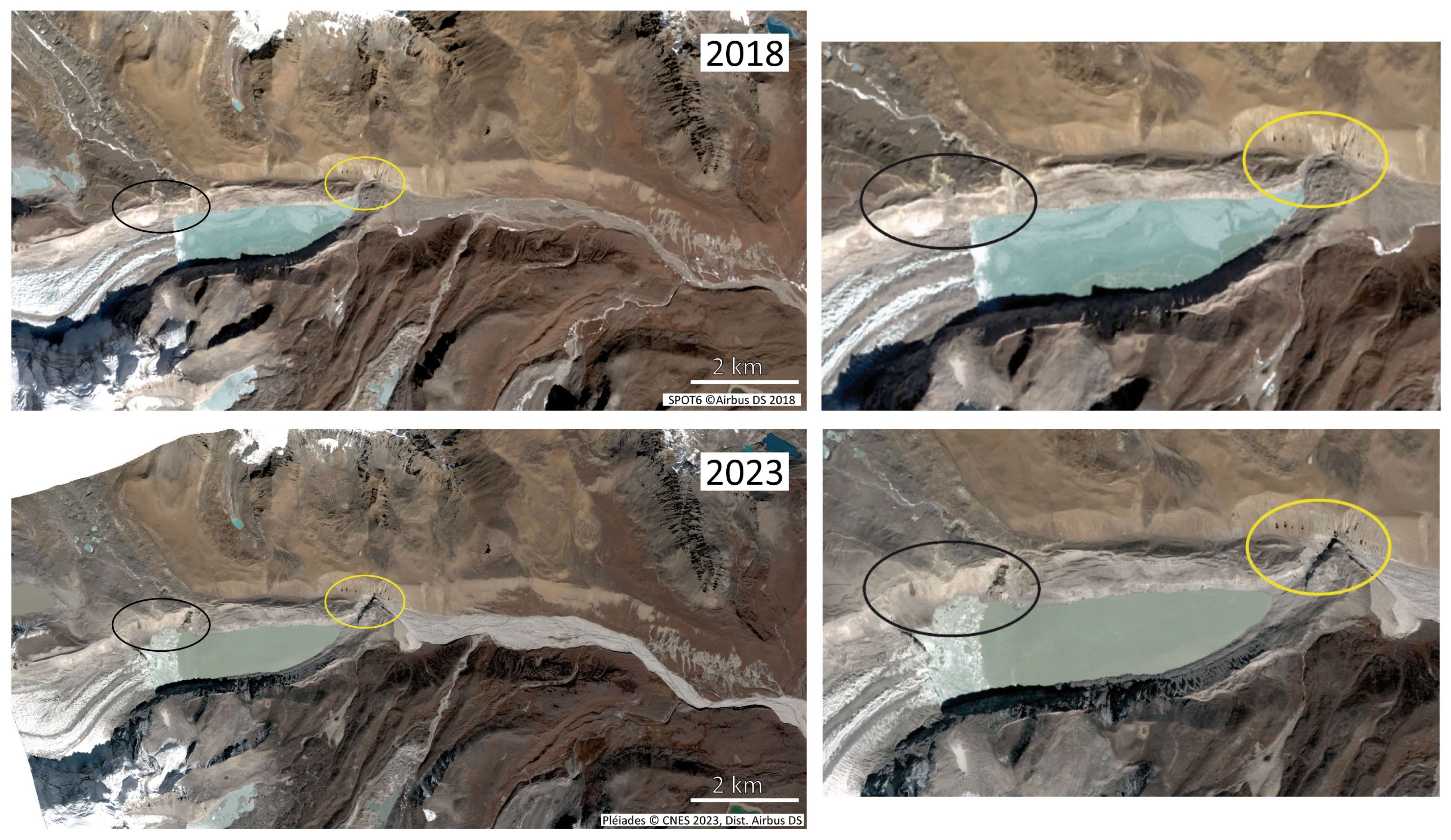
Submitted by Dr C.M. Martin-Jones on Thu, 13/02/2025 - 10:51
Researchers from the University of Cambridge were involved in a global study that pieced together events leading up to the devastating Sikkim Flood in India. The results show that human activity played a key role in the multihazard sequence.
On October 3rd, 2023, a large glacial lake in Sikkim, northeastern India, broke its banks and unleashed a catastrophic flood that killed at 55 people, left 74 missing and washed away a 1,200-megawatt (MW) hydropower dam.
Glacial lake outburst floods (GLOFs) like this occur when the lakes fed by retreating glaciers breach their enclosing moraine and ice dams, releasing huge amounts of water with devastating societal impacts.
As glaciers shrink due to climate change, the number and size of glacial lakes has increased. In the Himalayas, growing numbers of people are living near to these dangerous glacial lakes, and GLOFs represent a growing risk to downstream communities.
The South Lhonak Lake—the source of the 2023 flood—is among the region's largest and most rapidly expanding glacial lakes. By reconstructing events leading up to the South Lhonak GLOF, the new research sheds light on why these events occur and could help others prepare for similar events.
The research team involved scientists from 10 countries, including the universities of Hull, Leeds, and Cambridge, and non-governmental organisations and other stakeholders in India and Bangladesh.
The findings, published in the journal Science, show that the GLOF was triggered by a large landslide that collapsed catastrophically into the lake, breaking through the natural dam that retained the lake’s water.
Dr Maximillian Van Wyk de Vries and his PhD student Louie Bell, who are jointly based at Cambridge’s Departments of Earth Sciences and Geography, were part of the team.
“The South Lhonak GLOF was not a purely natural hazard,” said Van Wyk de Vries. “From the long-term growth of the glacial lake and loss of permafrost under climatic warming to the addition of floodwaters from a hydropower dam reservoir, the fingerprints of human activity are clear in this disaster.”
Van Wyk de Vries and Bell used satellite images to understand the pre-collapse conditions of the landslide which initiated this disaster. This information, alongside seismic data, meteorological data and field observations, allowed the team to reconstruct the complex event and its causes.
Pre- and Post-GLOF imageries showing the South Lhonak Lake and the GLOF deposits downstream of South Lhonak. Credit: Maximillian Van Wyk de Vries.
The reconstruction showed the outburst was triggered when a landslide comprising 14.7 million cubic metres of frozen glacial sediment collapsed into South Lhonak lake. This generated a 20-metre tsunami-like wave that breached and eroded the moraine dam that held back the lake, and released around 50 million cubic metres of water, a volume equivalent to 20,000 Olympic-sized swimming pools. This enormous volume of water then rushed down the valley causing severe damage downstream.
Van Wyk de Vries said they identified clear signs of slope weaknesses prior to the event, indicators which could be incorporated into early warning systems.
The GLOF was the topic of Bell’s Masters’ dissertation in Cambridge. “We were able to map how the landslide moved in the seven years prior to the failure that triggered the flood,” said Bell. “In some areas the slope next to the lake was moving at more than 15 metres per year, which gives us a clear signal for how we might spot other dangerous lakes in the future.”
According to the researchers, the findings underscore the inadequacy of current GLOF models, which often fail to account for erosion, sediment transport, and cascading processes. They also highlight the need for enhanced early warning systems, policy reforms, and adaptive risk management strategies, particularly in remote, high-altitude, vulnerable glacial regions like the Himalayas.
The study was led by Dr Ashim Sattar, Assistant Professor at the Indian Institute of Technology, Bhubaneswar, who said: “As we work to reduce the risks of GLOFs in the Himalaya, it is clear that we need a multi-faceted approach, including early warning systems, strengthened regulatory frameworks, a paradigm shift in GLOF modelling approaches, and robust preparation programs and community education.”
Reference: Sattar et al., ‘The Sikkim flood of October 2023: Drivers, causes and impacts of a multihazard cascade’, Science (2025) DOI: 10.1126/science.ads2659
Read more about the research in this blog post by study co-author Professor Dave Petley from the University of Hull.
Feature image: damage to highway by the GLOF and landsliding. Photo credits: Praful Rao (co-author).
Text adapted from a press release by Newcastle University.

